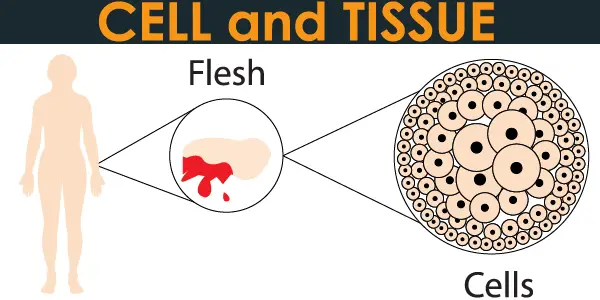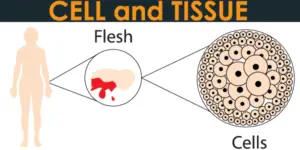
The difference between Cell and Tissue
The very basic and fundamental difference between Cell and Tissue is that a Cell is the very smallest unit of an organism and can only be seen at the microscopic level WHILE a Tissue is made by joining several cells together and can be seen at the macroscopic level or with naked eyes.

Is not it simple?
Let’s go more in detail to have a clear overview but before that, have a look at the picture explaining Cell and Tissue.
We can call the tiny piece of flesh in the picture a tissue.
Organisms are categorized into two types on the basis of cells which are unicellular and multicellular organisms. A unicellular organism is made by only one cell but a multicellular organism is made by joining of trillions of cells together.
Suppose, if we separate a very tiny piece of flesh from an organism that is a tissue of that organism. If we place that piece of flesh below the microscope we can observe that the flesh piece is made by joining of many cells together. This is the best scenario in order to understand a cell and tissue. You can visit https://www.microscopelog.com/ to find the right model and make the best scenario in order to understand the cell and tissue.
Difference between Cell and Tissue side-by-side:
| Cell | Tissue | |
| 1. | It can only be visible using a microscope. | It can easily visible by naked eye |
| 2. | It can be found in both multicellular and unicellular organisms. | It can only be found in multicellular organisms. |
| 3. | Cells are categorized into two types germline cells and somatic cells. | There are four types of tissues: connective, muscular, epithelial, and nervous tissues. |
| 4. | It is comprised of many cell organelles like mitochondria, nucleolus, Golgi apparatus, lysosomes, and nucleus, etc. | It is comprised of the same cells / same cells join together to make tissues |
| 5. | They join together to make tissue. | They join together to make an organ. |
| 6. | Reproduction, growth and metabolism are key functions of a cell. | There is only a unique function per tissue. |
| 7. | A cell can be either nucleated (with nucleus) OR enucleated (without nucleus) | A tissue is only formed by the joining of nucleated cells |
Also Read: Difference Between Plasma and Serum
What is a Cell ?
What is a cell: A cell is the base of an organism and it is a functional unit of every life on earth. All organisms are made of cells and life is not possible without cell. Organisms are categorized into two types on the basis of types of cells which are Prokaryotes and Eukaryotes.
Suppose a house is made of bricks. A brick here is a unit of that house and many bricks joined together to make that house. Similarly, an organism is the same as that which is composed of cells, and these cells joined together to make an organism and a single cell here is the unit of life or that organism same as the house.
If we suppose a human body then a human body is composed of nucleated cells which means humans are Eukaryotes. There are further two types of cells in a human body which are Somatic cells and Germline cells. Our muscles and all body organs are made of somatic cells but egg cells in females and sperm cells in males are compositions of germline cells.
What is a Tissue?
It is so simple to understand what is a tissue, It is a collection of cells or we can also say that many cells join together to make tissue. Cells are building blocks of tissue and tissues are building blocks of a body organ. Suppose if we separate a very very tiny piece from an organ that is called a tissue.
To remember all this just remember CTO which means, C for cells T for tissue and O for organs (C~>T~>O). Bones, livers, heart, kidneys, and all organs inside aa human body are made just the same as this.